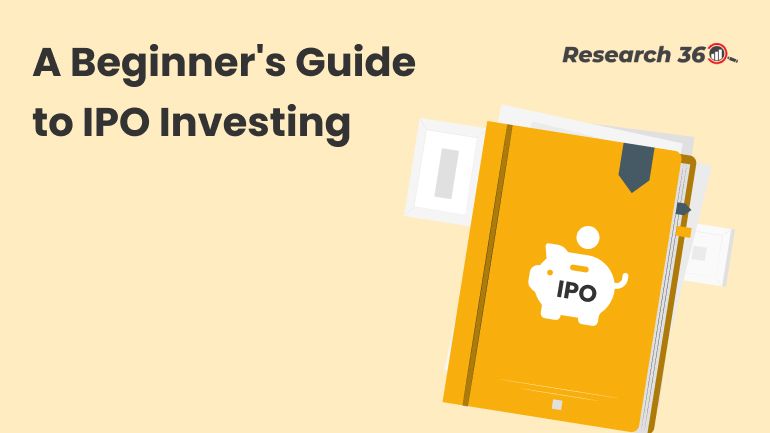IPO Full Form: What is it and Why Do Companies Opt for an IPO?

An Initial Public Offering is the process by which a company issues stocks to the public for the first time. Find out what it is and why companies launch IPOs.
One of the major objectives of most companies is to launch a successful IPO. An IPO is not only advantageous for the company issuing it but also for the investors who subscribe to the issue. In fact, it is such an important milestone for a company that can substantially enhance its presence, brand value, trust factor and financial situation.
As an investor, you might have heard of this term and may have even seen many companies opting to go through with an IPO. But have you ever wondered what the IPO’s full form in the share market is and how it works? Here’s a comprehensive guide that can help you understand it better.
What is an IPO?
The full form of IPO is Initial Public Offering. It is an extensive process through which a company issues its shares to the public for the first time. In exchange for issuing its shares to the public, the company receives funds, which it uses to fulfil the various objectives listed on the IPO offer document. Once the process is complete, the company’s shares are listed on the stock exchanges, where they can be traded freely without any restrictions.
Why Do Companies Opt for an IPO?
As an investor, you need to understand why a company might opt for an Initial Public Offering. Let’s take a look at a few reasons that can drive a company to issue its shares to the public.
Easy Access to Capital
An Initial Public Offering enables companies to raise significant capital from public investors. The funds raised by the companies are generally used for various purposes such as research and development, business expansion, acquisitions, debt repayment and for meeting their working capital requirements.
Valuation and Liquidity
When a company is listed on the stock exchanges post its IPO, the liquidity of its shares goes up significantly. Liquidity is the measure of how easy it is to buy and sell an asset without having to compromise on the prices. Furthermore, going public allows companies to determine their valuation easily based on investor demand and the pricing of their shares.
Brand Visibility
Initial Public Offerings usually generate substantial media coverage and public attention for the company. This can drastically increase brand visibility and awareness, which can in turn enhance a company's reputation, credibility and market presence.
Mergers and Acquisitions
Companies that are listed and traded on the stock exchanges generally have a major advantage when it comes to mergers and acquisitions (M&A). For instance, a listed company desirous of merging or acquiring another entity may choose to pay via shares instead of cash. This not only facilitates strategic partnerships and growth opportunities but also helps the acquiring entity retain its cash reserves.
Investor Exit Strategy
Another major reason why companies opt for an IPO is to provide their promoters and initial investors with an exit strategy. Venture capitalists, private equity firms and other early-stage investors can use the Initial Public Offering as an opportunity to monetize their investments by selling their shares to the public.
What are the Benefits and Drawbacks of an IPO?
Now that you’re aware of the meaning of an IPO and why a company opts for it, let’s move on to its various advantages and disadvantages. As an investor, you need to know the advantages and disadvantages of an Initial Public Offering to be able to make an informed investment decision.
Benefits of an IPO
Lower Cost of Capital
A company can choose to raise funds through equity or debt. Out of these two ways, raising funds through debt can be significantly more expensive than raising funds via equity. This is especially true in scenarios where the fund requirements of the company are enormous.
Not only does the company need to repay the borrowed amount, the interest costs alone can be a huge financial burden. However, that’s not the case with equity fundraising. The company is neither required to repay the amount nor pay any interest.
Enhanced Transparency
A company that wishes to issue an IPO is mandatorily required to adhere to all regulatory requirements and would be subject to increased transparency. This can lead to improved corporate governance practices like robust financial reporting and stringent disclosure standards and compliance measures, all of which can boost investor confidence.
Potential for Capital Appreciation
By investing in the IPO of a company, you get the opportunity to purchase its shares at an early stage at a low price. If the company performs well financially and the share price increases in the future, you get significant capital appreciation on your investment.
Access to Promising Companies
An Initial Public Offering may provide a chance to invest in companies with high growth potential, innovative business models and disruptive technologies. By investing in these early-stage companies, you can get access to opportunities that may not always be available in the public market.
Portfolio Diversification
Investing in an IPO can help you reduce your portfolio risk through diversification by allowing you to expand your holdings beyond traditionally available stocks and assets.
Drawbacks of an IPO
Cost and Complexity
Companies that issue IPOs incur significant expenses. This includes underwriting fees, legal and accounting fees, regulatory compliance fees and marketing expenses. Moreover, preparing and executing an IPO requires substantial time and resources and can potentially divert the focus of the management from core business operations.
Market Volatility
The share price of a newly listed company may be highly volatile during the early stages and can impact investor confidence and short-term returns. Various factors such as market conditions, investor sentiment and industry-specific dynamics can play a huge role in determining the price at which the shares trade on the exchanges.
Loss of Control
Since there’s a huge influx of new shareholders, the promoters and existing shareholders lose a portion of their ownership. This dilutes the control the existing shareholders have over the company and may even make it harder to take crucial business decisions.
Regulatory Compliance and Reporting
One of the major disadvantages of an IPO is the additional regulatory requirements and reporting obligations that companies are subject to. These regulations are often very extensive and include plenty of financial disclosures, audits, and compliance with securities laws. The increased scrutiny that listed companies face often requires dedication of additional resources and attention from management.
Increased Public Scrutiny
A company usually faces stringent public and media scrutiny once it is listed on the stock exchanges post a successful Initial Public Offering. Almost every aspect of the business such as its operations, financial performance and corporate decisions are thoroughly analyzed. Any negative news or publicity can impact investor confidence, the company's reputation and stock price.
What are the Steps Involved in an IPO?
As an investor, it is not enough to just get to know the full form of an IPO. You also need to be aware of the various steps a company takes to ensure that its Initial Public Offering is successful. Here’s a brief outline of the IPO process.
The passing of the Appropriate Resolutions
A company desirous of issuing an IPO convenes a Board of Directors’ meeting and an Annual General Meeting (AGM). In these meetings, resolutions are passed approving the decision to issue the shares to the public.
Appointment of a Merchant Banker
Once the resolutions are passed, the next step is the appointment of a merchant banker. A merchant banker is an entity that provides valuable assistance to the company in connection with the Initial Public Offering. Depending on the size of the IPO, a company may choose to appoint a single merchant banker or a group of merchant bankers.
Submission of the Application to SEBI
With the help of the merchant banker, the company files a Registration Statement, with the Securities and Exchange Board of India (SEBI). The Registration Statement is a document that consists of key details such as the company’s business, financial statements and the reasons for wanting to go public, among others.
Compilation of the DRHP
Once the SEBI accords its approval to the IPO, the company compiles the Draft Red Herring Prospectus (DRHP) with the help of the merchant banker. The DRHP, also known as the prospectus, is an important document that’s circulated to the public. It contains a host of details regarding the company, its business, financial health and details of the IPO.
IPO Roadshow
After circulating the DRHP to the public, the company markets its Initial Public Offering via advertisements to generate awareness and investor interest. Marketing is a crucial step in the IPO process; it can either make or break an IPO.
Submission of the Final Red Herring Prospectus
The company submits the final version of the Red Herring Prospectus to the SEBI. This version of the prospectus contains the latest financial information of the company and details such as the IPO opening and closing dates.
Fixing the Price Band
Right around the time of filing the final Red Herring Prospectus, the company also sets the IPO price band. A company may choose to either set a fixed price for the IPO or notify a price band.
Book Building Process
If a company decides to notify a price band, the IPO becomes a book-built issue. In the book-building process, interested investors are required to bid for the shares within the specified price band. Once all the bids are received, the company analyzes the prices and sets a cut-off price. All bids at or above the cut-off price would be eligible for allotment of shares. Meanwhile, all bids below the cut-off price are rejected.
Allotment of Shares
All the eligible investors are allotted the company’s shares by way of a credit transfer into their demat account. If the number of bids exceeds the total number of shares being issued (oversubscription), the shares are allotted to the eligible shareholders on a pro-rata basis. On the other hand, if the number of bids is lower than the total number of shares being issued (under subscription), the shares that have been unsubscribed are automatically taken by the merchant banker.
Listing on the Stock Exchanges
Once the share allotment is complete, the company’s shares are listed on the stock exchanges. The price at which the stock lists on the exchange is determined primarily by demand and supply.
Conclusion
With this, you must have now understood not just the full form, but also the meaning of an IPO. As you can see, an Initial Public Offering has both advantages and disadvantages for both the issuing company and the investors. Therefore, if you’re planning on investing in an IPO, remember to weigh both the advantages and disadvantages before making a decision.
















